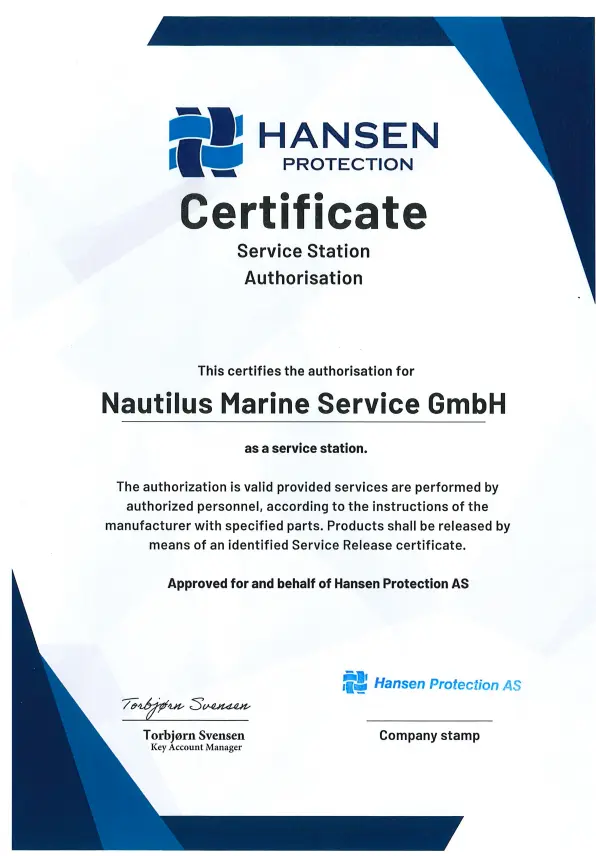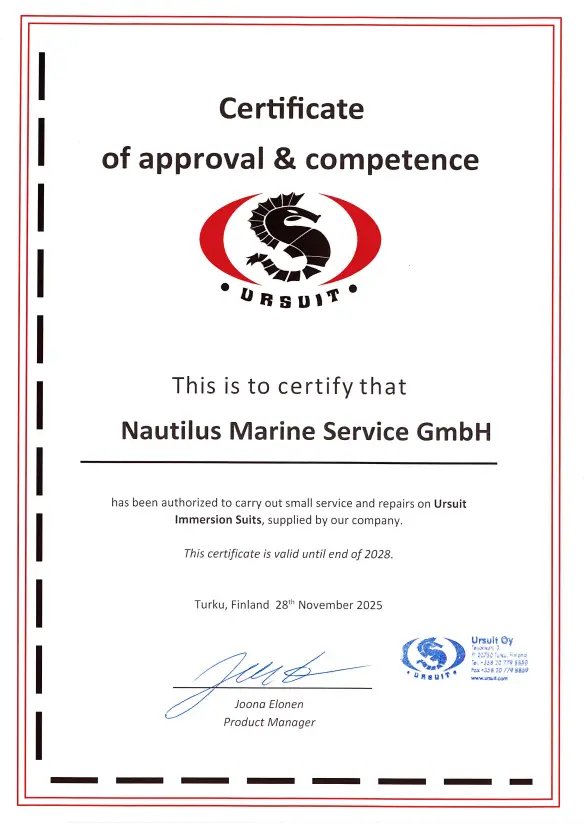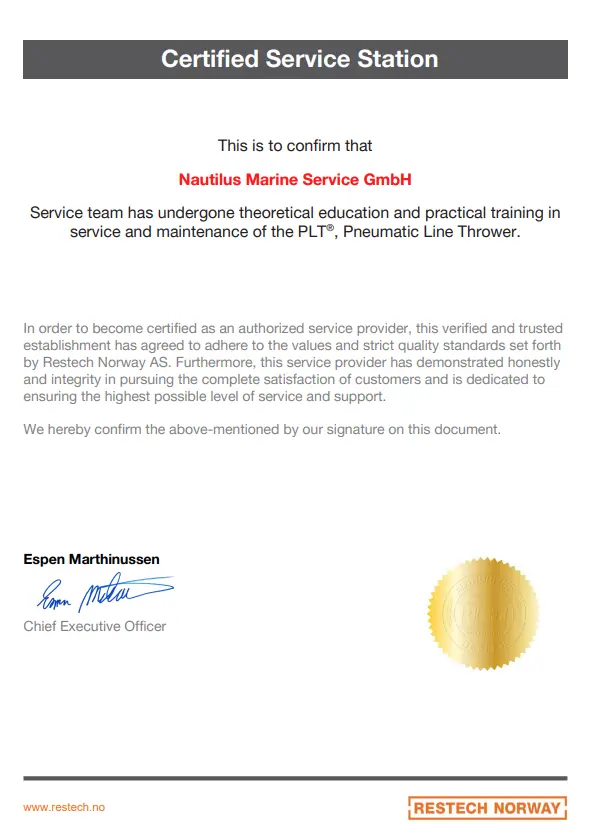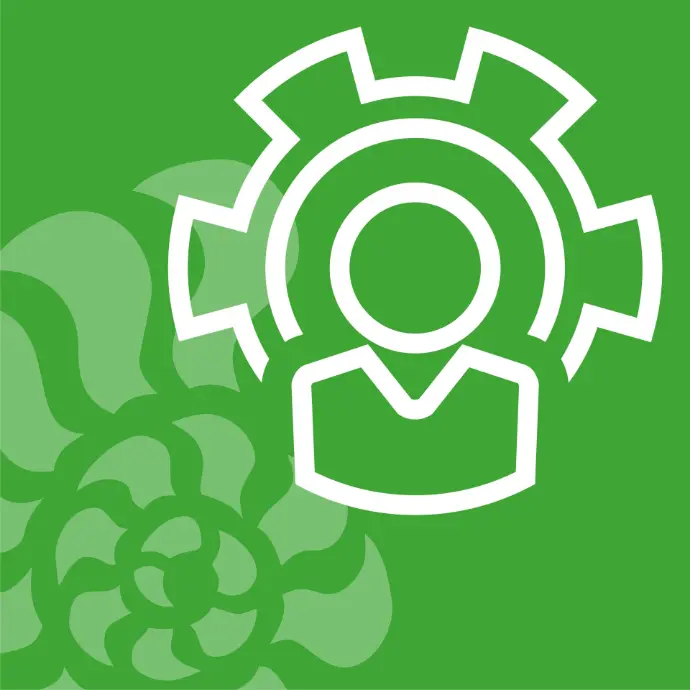Wichtiger Hinweis zur Wartung von Rettungsmitteln
Eine eigenständige Kontrolle oder Pflege Ihrer Rettungsmittel kann zur grundlegenden Funktionsüberprüfung beitragen, ersetzt jedoch keinesfalls die fachgerechte Wartung durch qualifiziertes Personal.
Um höchste Sicherheit und Zuverlässigkeit zu gewährleisten, empfehlen wir ausdrücklich, sämtliche sicherheitsrelevanten Ausrüstungen ausschließlich von einer autorisierten und zertifizierten Servicestation warten zu lassen.
Nur geschulte Fachbetriebe verfügen über die notwendigen Prüfgeräte, Ersatzteile und das Know-how, um eine normgerechte und vollumfängliche Wartung sicherzustellen.
Immersion Suit Maintenance
Maintaining immersion suits is vital to ensure they perform reliably and provide maximum protection in emergencies.
Key maintenance guidelines include:
Regular Inspection: Conduct routine checks to ensure the suit is free of damage, tears, or wear. Pay particular attention to seams, closures, valves, and cuffs for signs of leaks or deterioration.
Cleaning: Thoroughly clean the suit after each use, especially if exposed to saltwater or contaminants, using mild soap and warm water. Ensure the suit is completely dry before storage to prevent mold.
Buoyancy Chamber Check: Inspect the internal buoyancy chambers for damage or leaks. Make sure they can be fully inflated and retain air.
Lubrication of Zippers and Closures: Apply an appropriate lubricant to zippers and closures regularly to maintain smooth operation and prevent corrosion.
Replacement of Worn Parts: Replace worn or damaged components such as closures, valves, buoyancy chambers, or cuffs according to manufacturer guidelines. Always use genuine replacement parts to preserve safety and performance.
Documentation: Keep detailed records of all maintenance and inspections, including dates, performed tasks, and replaced components. This helps monitor the suit’s condition and plan future maintenance.
By following these guidelines, you can ensure your immersion suit is always operational and provides reliable protection in emergencies.
Lifejacket Maintenance
Routine maintenance of lifejackets is essential to ensure their functionality and safety when needed. Two types are distinguished: inflatable lifejackets and solid (foam) lifejackets.
Inflatable lifejackets typically have a maximum service life of ten years, provided they are serviced every two years by an authorized service station or the manufacturer. For SOLAS-compliant lifejackets, annual servicing is mandatory. After each inspection, a service tag is attached to indicate the next scheduled maintenance. In the case of ISO lifejackets, biannual servicing is permitted up to the ninth year. In the tenth year, the maintenance interval shortens to one year, and from then on, only the manufacturer is authorized to carry out annual servicing, up to a maximum lifespan of fourteen years. However, from year ten onward, lifejackets may need to be decommissioned for safety reasons, as materials can become brittle or lose their integrity over time.
Solid (foam) lifejackets require minimal maintenance but also have a maximum service life of ten years in recreational boating. They should be subjected to a thorough visual inspection once a year, with particular attention paid to signs of damage such as tears, abrasions, discoloration, or fraying in the fabric and straps. Prolonged exposure to sunlight, heat, or improper storage conditions can also lead to a reduction in buoyancy. If any visible damage is present or there is doubt about the functionality of the lifejacket, it should be removed from service immediately and inspected by a qualified dealer, authorized service station, or the manufacturer.
Line-Throwing Device Maintenance
Proper maintenance of Restech line-throwing devices is crucial to ensure optimal performance, safety, and lifespan. Key maintenance points include:
Regular Inspection: Check that all components are intact and functioning correctly. Pay special attention to the compressed air or gas supply, line deployment mechanism, and all moving parts for wear or damage.
Cleaning: Keep the device clean and free of dirt, salt deposits, and other contaminants using a damp cloth. Ensure no moisture enters sensitive parts.
Protecting Moving Parts: Lubricate according to the manufacturer’s instructions, using approved lubricants only. Avoid leaving lubricant residues in the air passages to ensure smooth operation and avoid damage.
Air or Gas Supply Checks: Regularly verify that the device’s air or gas supply is functioning properly and reaches the correct pressure. Inspect pressure cylinders and fittings for leaks or damage.
Replacement of Worn Parts: Timely replace parts subject to wear, including ropes, seals, valves, and other consumables.
Documentation: Maintain accurate records of all maintenance and repairs, including dates, tasks performed, and parts replaced. This ensures traceability and aids in scheduling future maintenance.
By adhering to these care and maintenance guidelines, you ensure your Restech line-throwing devices remain reliable, fully functional, and durable.
Zertifizierte Service Station
Als offiziell autorisierte und zertifizierte Service Station bieten wir Ihnen Wartung und Inspektion von Rettungsmitteln auf höchstem Qualitäts- und Sicherheitsniveau. Unsere Servicetechniker sind speziell geschult und arbeiten nach internationalen Standards sowie den Vorgaben der jeweiligen Hersteller.
Wir verfügen über alle erforderlichen Zertifikate, Prüfgeräte und Fachkompetenzen, um eine vollständige, normgerechte und zuverlässige Wartung Ihrer sicherheitsrelevanten Ausrüstung sicherzustellen.
Damit gewährleisten wir, dass Ihre Rettungsmittel jederzeit einsatzbereit und voll funktionsfähig sind.





